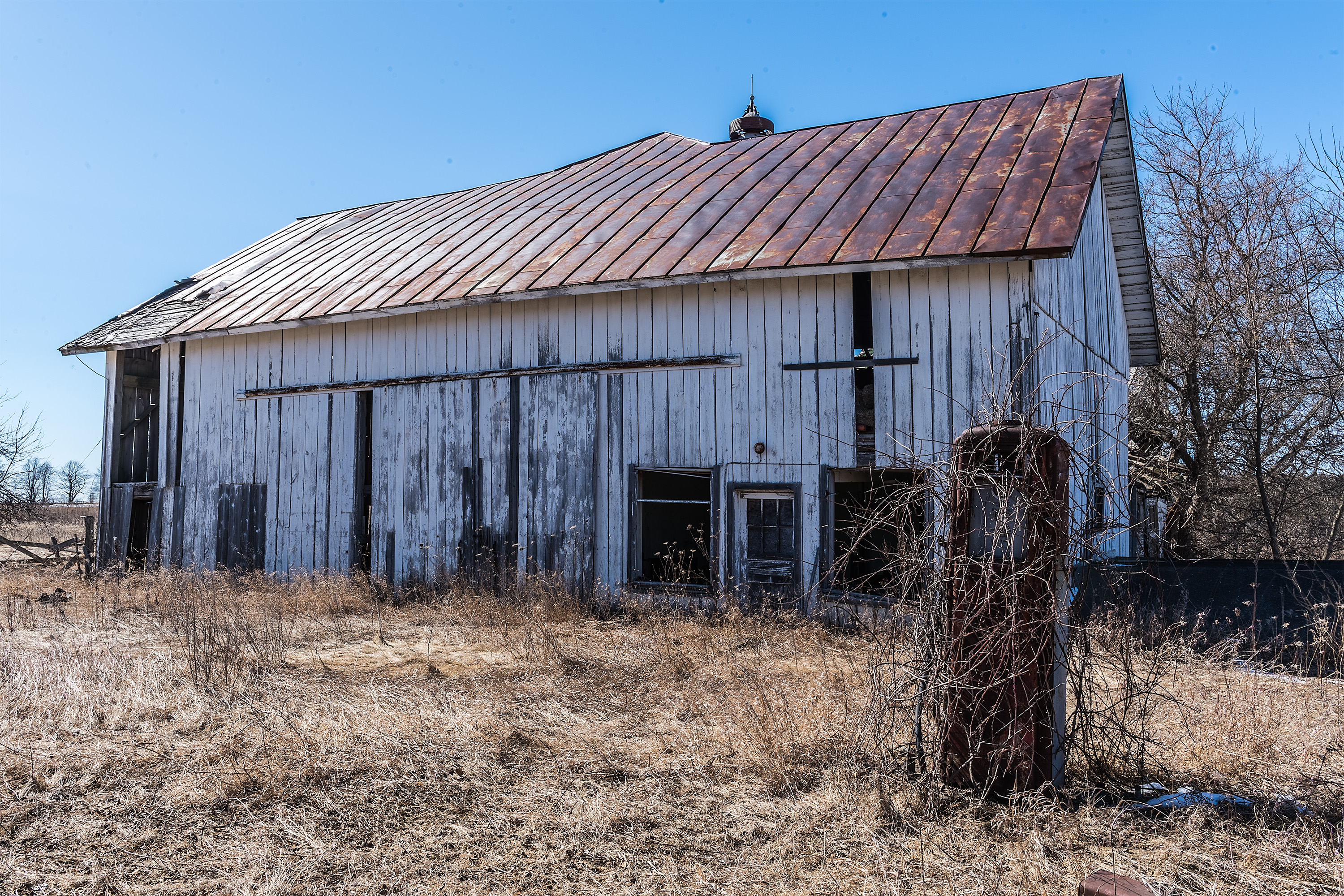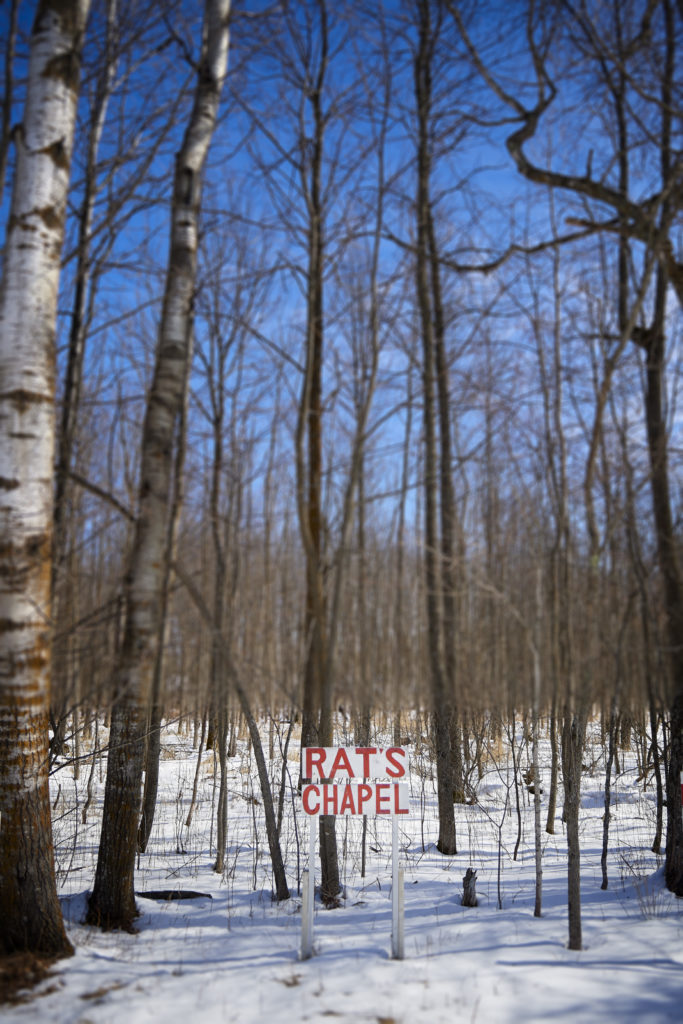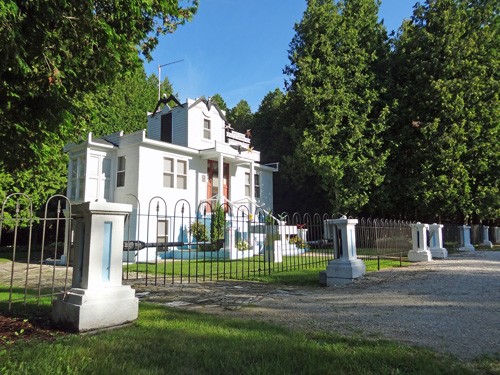Curious Door – the Peninsula’s Most Mysterious Places
- Share
- Tweet
- Pin
- Share

Speckled amidst the farms, bluffs and manicured estates of Door County are sites that seem a step out of place. There are curiosities that make you ask, “I wonder what the deal is with that?”
You’ll pass them time and again, always asking the question, if only to yourself. Here we track down the stories of some of Door County’s most curious sites.
Chateau Hutter
It’s hard to travel down Bay Shore Drive from Sturgeon Bay to Egg Harbor and not wonder what happened to the long-lost resort known as Chateau Hutter.
Driving north from Sturgeon Bay, an expanse opens up to the bay side of the drive, revealing a glimpse of the water and the remnants of an assemblage of buildings bearing the look of a resort. At the roadside is a weathered wooden sign between two stone pillars with the words “Chateau Hutter.”
The resort was the dream of John Hutter, an accountant from Chicago who loved to travel and yearned to create a European-style getaway in Door County. In the late 1940s he acquired 320 acres and in 1950 opened his resort built with stone from nearby beaches and pine harvested from the bluffs across the road.
In those early years the resort was beautiful, but Hutter advertised it as a step above, and claimed “only on the French Riviera will you find a comparable environment,” including a world-class 27-hole golf course that he never completed. The resort never lived up to Hutter’s over-the-top proclamations, however, and in 1965 the Door County Chamber of Commerce refused to accept his dues and expelled him from membership.
Hutter believed he was was the victim of a mean-spirited campaign by Door County’s good old boy network and filed suit against the Chamber, claiming that his expulsion put him out of business. He represented himself, to ill effect, and lost. His later years were absorbed in legal and tax battles with the town, the county, the chamber and the City of Chicago.
In the late 1980s Hutter’s attorney, Al Beaver, announced grand plans for a music school for disabled children. Beaver reportedly lent Hutter $200,000 to spruce up the property, but the school never materialized. Beaver foreclosed on the loan and assumed ownership of much of the property when Hutter died in the mid-1980s. Beaver continued Hutter’s habit for litigation, challenging tax assessments and tossing about lawsuits like a baseball coach hitting ground balls to his infield. Beaver died Oct. 31, 2015, leaving the property to his daughter Amy Bevacqua. Rumors continue to circulate that it may yet be developed, but for 50 years the enviable property has sat empty, an attraction for the curious and a sad reminder of Hutter’s grand plans.
Myles Dannhausen Jr.

The Chateau Hutter sign remains on Bay Shore Drive near Sturgeon Bay. Photo by Matthew Smith.
Fish Creek’s Gnome Tree
On the northwest corner of County Highway A and Gibraltar Road in Fish Creek, a gaping hole in a tree trunk is home to some unlikely creatures. Gnomes and other figurines are perched on the trunk through every season and few people, other than the person who put them there, know why.
“My stepdaughter and her husband came up to visit. They brought these gnome statues and they were driving me crazy,” said a woman we’ll call Cheryl, since she prefers to remain anonymous. “They would leave them all over the house.”
Driving past the intersection on her daily commute to work, the hole in the corner tree seemed like a great place to put these annoying gnomes. She collected six of the four-inch-high gnomes sprinkled around her house and placed them in the tree.
“I didn’t tell anybody,” Cheryl said. “Nobody knew who did it and it was mysterious.”
Pretty soon, the tree even became a mystery to Cheryl.
“All of the sudden people were putting things in there,” Cheryl said. “Notes, candy, and it just escalated.”
Now retired, Cheryl drives past and smiles at a father lifting his daughter up to see the tree, or at other random figurines that pop up every once in awhile. But she doesn’t shy away from the very practical reason the tree now piques so much curiosity.
“I’m a little nuts,” Cheryl said, laughing. “Basically, it was just to get those damn gnome statues out of my house.”
Jackson Parr

Meyer Klass Implements
At the intersection of Highways 42 and 57 just north of Sturgeon Bay, a handful of barns, homes and sheds struggle to stand another day. The buildings are seen by nearly everyone who lives or vacations beyond the city, 40 years of neglect serving as the welcome sign to Northern Door.
For town officials, the gas pump wrapped in overgrowth out front of the property is a source of consternation. Nobody can say for sure if the pump was a decoration or actually connected to an underground gas tank.
The property was once the home to Meyer Klass, a wheeler-dealer who traded horses, sold farm machinery, and operated one of the largest dairy farms in the area for 40 years. A well-known (if not always well-loved) character, Klass dressed well, spoke with a bit of a lisp through teeth that always chewed on a fat cigar, and drove a shiny Cadillac.
“He was known for fast dealing,” said Don Rudolph, who grew up a couple miles down the road.
Linda Wait grew up on another farm down the road.
“He had Shetland ponies, and in winter he would offer to let people board them for the winter,” she said. “We brought home a pregnant Shetland pony one winter and got to see a foal be born.”
Klass opened up shop in 1938, and in 1949 became the local Case IH dealer and was well-known for his radio ads that ran the tagline “Be a live wire, deal with Meyer!”
Some local farmers had their own line for the fast-dealing Klass.
“Deal with Klass, get a kick in the ass is what the farmers said,” said Rudolph, whose dad once brought a tire to Klass for repair, only to return the next day and find out his tire had been sold. Klass gave him a replacement tire that didn’t match, and Rudolph’s father never returned.
Klass milked 51 cows, a huge number for the time, and old-timers say the farm was always impeccably maintained, but in 1968 Case pulled his contract as the company moved to dealerships in modern cinder block buildings. Klass’s health deteriorated until he was confined to a wheelchair. After he died in 1978, the property passed to a sister who rented it out for a time. Since she died, it fell into the hands of a niece, Nikki Henkin, who lives in New York City. Neighbors can’t recall the last time anyone visited the property, and today, the roofs are caving in, windows are broken, and front doors rattle in winter winds.
Henkin keeps up on the taxes for the homes and surrounding 58 acres of rented farmland, but the Town of Sevastopol and County Sanitarian John Teichler have had no luck convincing her to clean up the property or confirming whether there’s a gas tank abandoned under that pump. It’s now on the town’s watch list as a risk to public health and safety.
The property has been listed for sale over the years and received offers, but none good enough for Henkin, who seems content to ignore the property. While it’s a nuisance to some, come July you’ll likely see painters from the Peninsula School of Art’s Plein Air Festival camped on the grounds, capturing on canvas a relic of a lost era before time takes its final toll.
Myles Dannhausen Jr.

Photo by Len Villano.
Rat’s Chapel
The road between Sturgeon Bay and Algoma is so flat and fast, many who drive along County Highway S probably zip right past the few white picket posts holding up a sign saying “Rat’s Chapel” painted in fat red letters.
There is no building behind the sign, certainly not a chapel. But down the road a few hundred yards, at the Stage Road Inn, owner and bartender Tom Schmelzer knows the story behind the sign like any good bartender would.
“He owned and lived in the house in that land where that sign is,” Schmelzer said of a man named Dale, who went by the nickname “Rat.” “He was a logger and had been a logger for many years.”
Schmelzer described Rat as a unique character, burly and hardened from his years of logging and a frequent visitor to the local bar.
Others described him to Door County Advocate columnist Peter Devlin as a gentle soul, which is how Devlin described him in a column on Rat’s Chapel in 2014. After that column published, Devlin heard from many people who had a different story about Rat.
“It was rife with errors,” Devlin said of his first column, which he now calls the “sanitized” story of Rat’s Chapel.
It turns out, Rat enjoyed the company of women in a trailer on his property long after the bar closed for the night. He was a gentle soul who liked to party, a detail Devlin hadn’t mentioned. Devlin wrote a new column a month later to clear things up.
Schmelzer said Rat struggled with depression. While he can’t remember when exactly the signposts for Rat’s Chapel were erected, it was sometime after April 22, 2002, when Rat was found in the woods off of Helmholz Road. He had killed himself.
“That became a little monument for the fact he was a logger all that time,” Schmelzer said. “He lived in the woods, that was his life.”
Devlin believes Rat’s nephew, John, put up the memorial for his uncle. Schmelzer doesn’t know who did it or why.
Whether the chapel can be viewed as the entrance to a wooded sanctuary for a lifelong logger or stakes for the spot where Rat enjoyed cold beer and the company of women is reserved for those who knew him.
While there are fewer people who knew him than there were 16 years ago, and memories fade in time, the sign still stands to the side of the road. It looks like there’s a fresh coat of paint.
Jackson Parr

Rat’s Chapel. Photo by Len Villano.
The Valkyrie
A couple of miles south of Egg Harbor, a curious sculpture stands alone in front of the former Sunnypoint School on Highway 42 across from Sunnypoint Gardens. For those familiar with the tornado that ripped through Egg Harbor in August of 1998, it seems obvious that the twisted metal sculpture is an homage to the tornado.
“It has nothing to do with the tornado,” its creator, Latvian artist Janis Mintiks, told the Peninsula Pulse in 2012. “It actually started about 40 years ago when I was studying at the Layton School of Art in Milwaukee.”
There Mintiks was out fishing one day and came across the shallow remnants of an old wreck. He pulled some hunks of steel out of the water and set to work reshaping them and fashioned the metal into “The Valkyrie,” a female figure of Norse mythology who decides who dies and wins in battle.
“It’s inspired by the Wagner opera,” Mintiks said, referring to the composer’s famous “Ride of the Valkyries.”
So why does it stand in front of an old schoolhouse in Egg Harbor?
“I didn’t have anywhere else to go with it,” said Mintiks, who now lives in Taos, New Mexico.
Mintiks gave the sculpture to his friend and owner of the property, Guntis Lauzums, as a gift before the tornado came through. It stood behind the schoolhouse, but after the tornado some men from the Lions Club were helping clean up debris when they found the sculpture.
“One of the guys said, ‘Look what the tornado did, it twisted it all to hell,’” Mintiks said. “We let them believe what they wanted to. The tornado certainly made a mess out of that part of the world.”
They added some parts to it when they placed it out front, giving it a very particular purpose.
“It’s not minimal, not abstract,” he said. “It has two legs and some wings. It’s pretty literal. But, people have always thought it had something to do with the tornado.”
Myles Dannhausen Jr.

The Valkyrie. Photo by Myles Dannhausen Jr.
Baileys Harbor Birdhouse
Just north of the downtown Baileys Harbor corridor, there is a curious concrete structure painted blue and white. In the summer, it dons a collection of carved wooden birds that are as storied as the man who carved them.
Albert Zahn, a German immigrant who arrived in the United States as a teenager in 1879, began building the house in the early 1900s after retiring from a dairy farm a few miles northeast of Baileys Harbor. He poured the concrete walls eight inches thick and added logs stretching two stories high for additional support.
The building’s listing on the National Register of Historic Places describes its unique concrete structure and design as one reason for its significance. But most people would say it’s the second reason for the house’s inclusion in the list — the man who lived there — that encompasses the true history of the building.
Zahn was an avid woodworker, creating bird sculptures to place outside his new house or sell for 35 cents each.
“Historic photographs illustrate the profusion of carvings that he placed around the yard and on the building itself, creating a unique, visionary spectacle,” the National Register of Historic Places wrote upon the home’s induction in 2000.
“My great-grandfather died the year I was born,” said Randy Zahn, great-grandson of the storied wood carver. “I was always curious about that house. You heard a couple of stories about it from the family but the family took it for granted.”
The house was sold shortly after Albert Zahn died in 1953 and has been with its new family for two generations. While Randy Zahn laments the family’s loss of the house, he understands that back then, the building was little more than a block of concrete and his great-grandfather was little more than a wood-carving hobbyist.
He said when the new owners moved in, they called Albert Zahn’s children, asking if they wanted to take some interesting artifacts of their father’s that were left in the house. It wasn’t until a few years after Albert Zahn died that his work was picked up by the folk art scene, ending up in places like the Art Institute of Chicago and the Guggenheim Museum in New York City.
Randy Zahn keeps close to the home, looking after it for the new owners, whom he said are exceedingly private people.
“He comes up here the month of July,” Randy Zahn said of the house’s owner. “It was a summer home for him when he was a little kid so it’s kind of special for him and he wants to keep it.”
Randy Zahn adds the family that bought the house from the Zahns had the financial means to restore the structure, which he is thankful for.
“If it hadn’t been for him, the family would have not been able to afford to do all the things that had to be done to the house and it probably would have been bulldozed by now,” Randy Zahn said. “Even now it’s still expensive to maintain and he’s able to do that, so it’s a good thing that he has it…In that way I’m grateful he owns it.”
As the weather warms in spring, Randy Zahn will drive a few miles from his home on the original dairy farm outside of Baileys Harbor to the Birdhouse, mounting his great-grandfather’s traditional wooden bird carvings and putting up the eagle gate as passersby on Highway 57 look on.
Jackson Parr

The Albert Zahn Birds Park home in Baileys Harbor.
